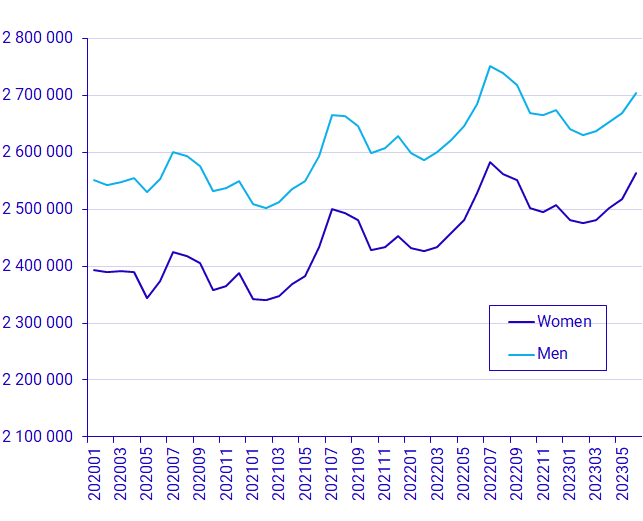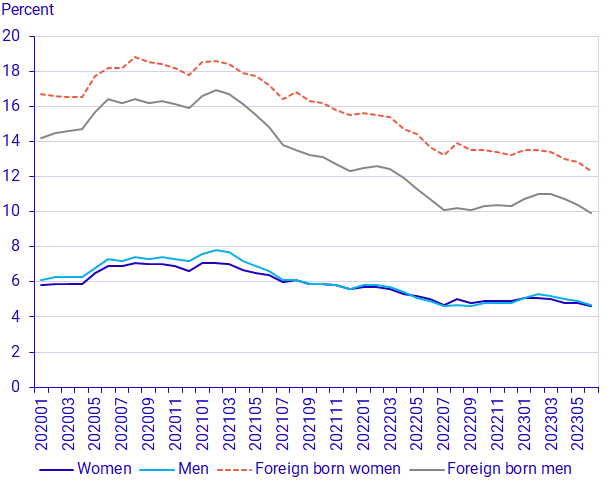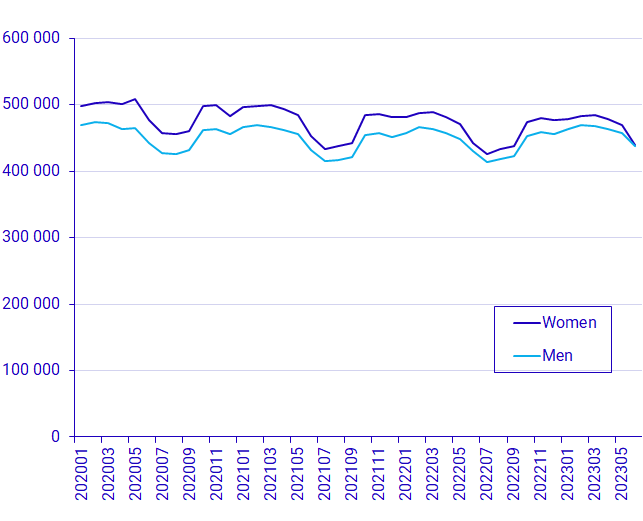Population by Labour market status, 2nd quarter 2023
Employment continued to increase in the second quarter of 2023
Statistical news from Statistics Sweden 2023-08-31 8.00
People in employment aged 15 to 74 numbered 5 202 000 in the second quarter of 2023. This is an increase of 63 000 people compared to the same period of 2022. In the 16 to 64 age range, 250 000 people were unemployed. This equals a share of 4.8 percent expressed as a percentage of the labour force and a decrease of 0.3 percentage points from the second quarter of 2022.
People in employment
The number of people in employment aged 15 to 74 increased in the second quarter of 2023 by 63 000 compared with the same period of 2022, amounting to 5 202 000. Fewer women than men were employed. A total of 2 528 000 women and 2 675 000 men were employed.

The employment rate – the number of employed people in relation to the population – was 67.6 percent among women and 68.9 percent among men. Compared to the second quarter of 2022, the employment rate increased by 0.7 percentage points for women and 0.3 percentage points for men. The employment rate is largely affected by the demographic composition of the population, which is of significance when comparing municipalities, for example. Young and older people tend to have a lower employment rate and are present in other labour market status categories.
The unemployed
The number of unemployed people aged 16 to 64 in the second quarter of 2023 was 250 000. This is a decrease of 14 000 people compared with the second quarter of 2022. The number of unemployed women was 120 000 and the number of unemployed men was 130 000. The relative unemployment rate – the proportion of unemployed people in relation to the labour force – was 4.7 percent for women and 4.9 percent for men. This corresponds to a reduction in unemployment among women of 0.4 percentage points and among men of 0.2 percentage points compared with the same period of 2022.
Unemployment is higher among foreign born people than among those born in Sweden. Unemployed foreign born people aged 16 to 64 numbered 146 000 in the second quarter of 2023. This is a decrease of 11 000 people compared with the second quarter of 2022. The number of unemployed foreign born women was 77 000 and the number of unemployed foreign born men was 68 000. The relative unemployment rate was, among foreign born people, 12.7 percent for women and 10.3 percent for men. This equals a reduction in unemployment among women of 1.6 percentage points, and 1.0 percentage points among men compared with the same period of 2022.

People outside the labour force
The number of people outside the labour force aged 20 to 64 was 915 000 in the second quarter of 2023. This equals a share of 15.4 percent expressed as a proportion of the population in the same age group. Compared to the same period of 2022, the number of people outside the labour force increased by 4 000 and the proportion is unchanged.
There are somewhat more women than men outside the labour force. Out of the total number of people outside the labour force in the second quarter of 2023, 50.8 percent were women and 49.2 percent were men. There were 9 000 more women than men. The labour market status categories that are outside the labour force are student, pensioner, sick and others.
There are fewer people outside the labour force in the summer than during other parts of the year. This is mainly because some people who are students during term time work during the summer and are classified as employed.

Definitions and explanations
BAS, Labour market status of the population, presents statistics based on administrative data concerning aspects such as the number of people in employment, unemployed people and people outside the labour force for the registered population aged 15 to 74. The statistics can be used to describe current status, but also the progression over time. They illuminate both the entire population and smaller groups, such as detailed age groups at the municipal level.
The statistics contain estimates of the number of people broken down by labour market status: Employed, unemployed, student, pensioner, sick and others, with the labour force consisting of employed people and the unemployed. The definition of labour market status is hierarchical, which means that a person can only be assigned one labour market status, and it is determined according to the order of precedence above.
For people with several jobs, one principal job is determined using remuneration data.
The statistics are by month. Quarterly and annual data is calculated as the average of the months included.
Statistics Sweden launched the product “Labour market status of the population” (BAS) in May 2022. Initially, BAS are “statistics under development” but with plans to shortly present them as official statistics.
Feel free to use the facts from this statistical news but remember to state Source: Statistics Sweden.
